BOTTICELLI - ADORATION OF THE MAGI

Sandro Botticelli, Public domain, via Wikimedia Commons
1475-76
|
- Around the year 1475, the Florentine banker and financial broker, Gaspare di Zanobi del Lama commissioned the painting,
in association with the Medici family.
- Gaspare, a banker, built the chapel in Santa Maria Novella to atone for his sins
because at the time, bankers' work was considered the sin of usury.
- Tempera on
wood panel.
- This was painted 20 years before DaVinci
painted Last Supper.
|
This painting depicts the Biblical story of the Three Magi following a star to find the newborn Jesus. The image of the altarpiece centers on the Virgin Mary and the newborn Jesus, with Saint Joseph behind them.
(Wikipedia)
|

Magi gift |
- There are at least four different stories portrayed; 1)
Birth of Jesus and the Magi visit 2) Assassination of Medici
brother 3) Botticelli playing jokes on fellow artists (mainly
Leonardo) 4) Spiritual journey.
- There is also a 5th story
and that is how this relates to Caesar who mirrors the Medici.
- And then there is the past and future dream.
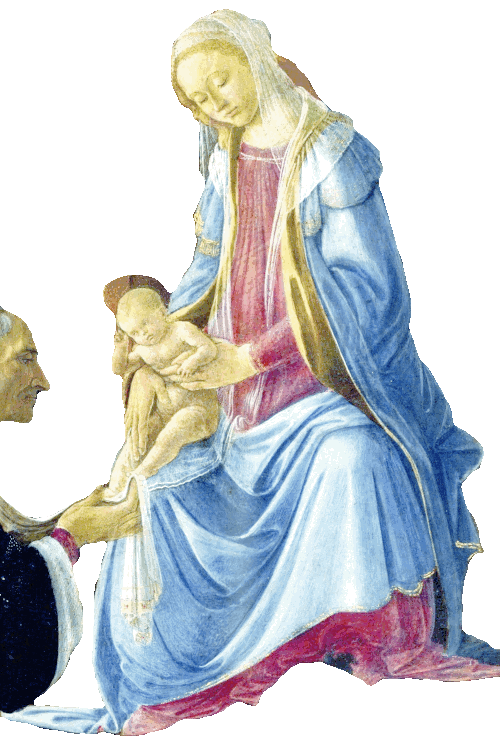
Cosimo with Mary and Jesus |
- It contains the portraits of Cosimo de' Medici, his sons Piero and Giovanni, and his grandsons Lorenzo and Giuliano.
- There are also portraits of the donor and, Botticelli himself, standing at the front on the
far right.
- Mary with Jesus sits at the center of the scene, under the shooting star that guided the Magi on their journey.
- She wears an azure-blue robe over a rose-pink dress, and a shell-pink veil covers her head and body.
|
It was Gaspare di Zanobi del Lama who commissioned this particular painting. A wealthy agent of the bankers’ guild to which the Medici also belonged, some see him depicted in the old white haired man on the right side of the painting. He seems to be pointing at himself, as if to say “I’m the one who paid for this”.
(lovefromtuscany.com)
|
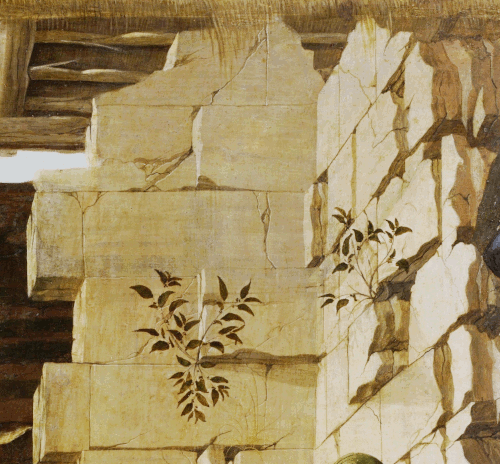
Classical ruins |
- The painting is set in a landscape with classical ruins, including an arcade in the middle ground
and features a a monumental building that resembles a ruined basilica.
- Much the same as Leonardo's Adoration of the Magi.
- Additionally there is a peacock, a brown cow, and a gray donkey.
|
While the Holy Family sits humbly amid an ancient ruin, all around them the three kings and other figures seem focussed on everything but the Christ child. But a light coming from above and the peacock, symbol of immortality, remind us that this is very much a sacred scene.
(lovefromtuscany.com)
|
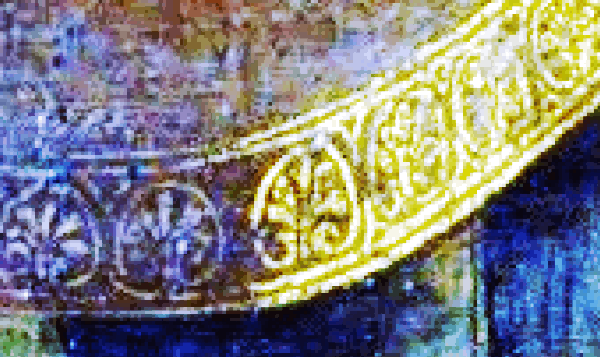
Asian textiles |
- Many of the characters are depicted wearing different types of textiles that have bands of gold at the shoulders and the hems; these likely refer to Asian textiles known as
'tartar cloths' or Islamic-style tiraz textiles with inscriptions.
- Examples of these exotic luxury goods were available in various church collections across the different Italian city-states.
- Luxury textiles from Asia and Islamic lands became signifiers of wealth, prestige and thus functioned as status symbols.
- Fabrics were very important commodities for the early
traders on the Silk Road.
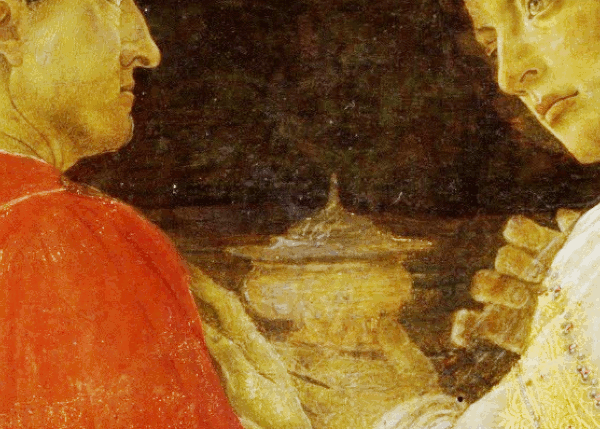
Magi's
hold golden cup |
- Different types of expensive luxury items were included in the story thereby reflecting Christian European fascination with the exotic.
- For example, there are several different types of gold cups and receptacles that are presented by the three kings.
|
Patrons and painters throughout Europe were
particularly drawn to this story, especially in
Florence, Italy. Wealthy patrons may have been particularly drawn to the display of riches and finery that were displayed in the magi's expensive and exotic clothes and gifts.
(Wikipedia)
|
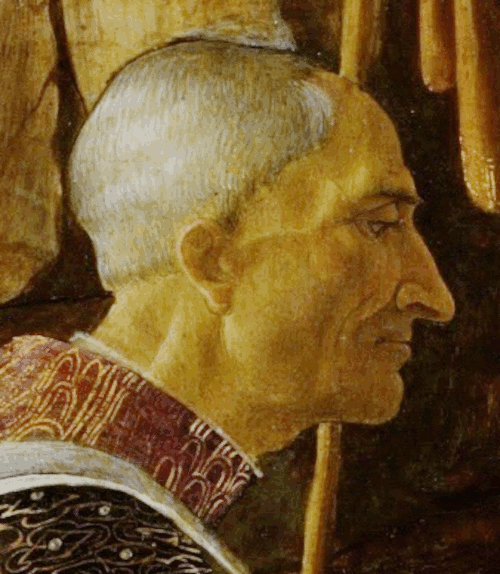
Cosimo de' Medici
as Pope Sixtus IV
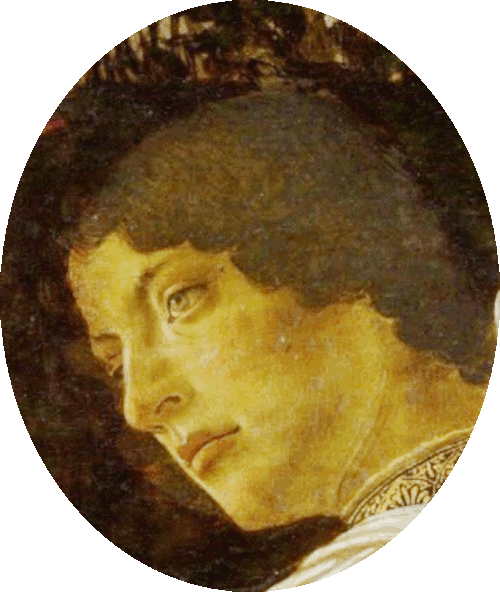
Giovanni de' Medici
Son |

Giuliano de' Medici
Grandson |
- Botticelli, who was known for his expressive
portrayal of mythological figures and religious themes, used
the Medici family as models and included several generations of the family.
- Members of the important families in Florence were often
portrayed as Magi or as their companions in paintings with
religious motifs that were commissioned by various
congregations.
- There are several representations of this motif which depicted portraits of Medici
that were created by the most known Italian renaissance artists such as Gozzoli, Botticelli, Veneziano, Lippi
and Ghirlandai.
|
One of the most important congregations was so-called Brotherhood of the Magi, (Compania dei Magi, also called Confraternity of the Star). Their selected members also included the Medici family.
(travelingintuscany.com)
|
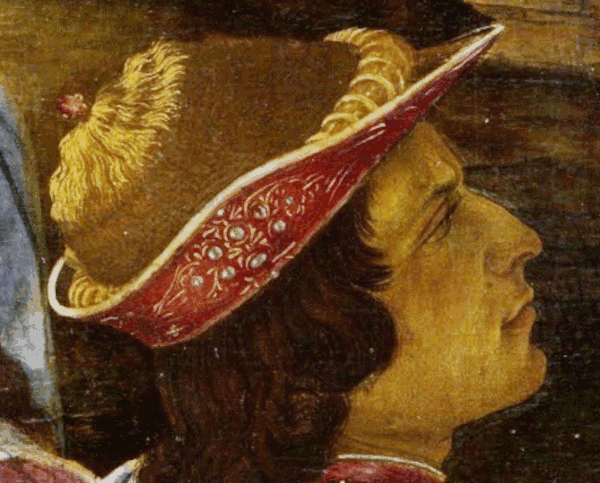
Lorenzo de' Medici
Grandson
|
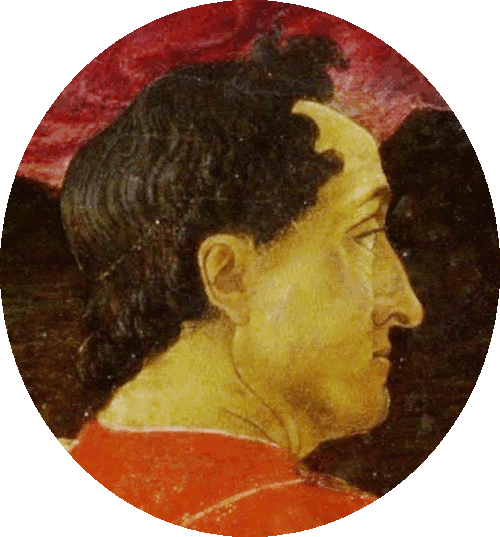
Piero de' Medici
(Gouty)
Son |
- The aged Cosimo is kneeling in an act of devotion at the feet of the Virgin,
his eldest son Piero in a red cloak seen from behind at the center of the composition, and on his right the other son Giovanni, dressed in white and also on his knees,
constituting the 'Three Magi.'
-
Identities of the other figures are more controversial.
- Some
believe the young man leaning on bis sword is a portrait of Lorenzo the Magnificent, although others
believe that is Giuliano.
- The only thing that is sure is that the protagonists of the sacred representation, the three Magi, are Cosimo, Piero and Giovanni de' Medici
and that all three had already passed on.
|
What would have appeared reckless at the very least elsewhere in Italy and Europe was evidently quite feasible in the Medicean Florence of the late fifteenth century. A family of wealthy private citizens which had established its dominance while maintaining a formal respect for republican institutions, it exercised de facto such power as to render possible blatantly and sickeningly adulatory public tributes.
(travelingintuscany.com)
|
|
Analysis by
Catchlight - A light that shines in the
dark |
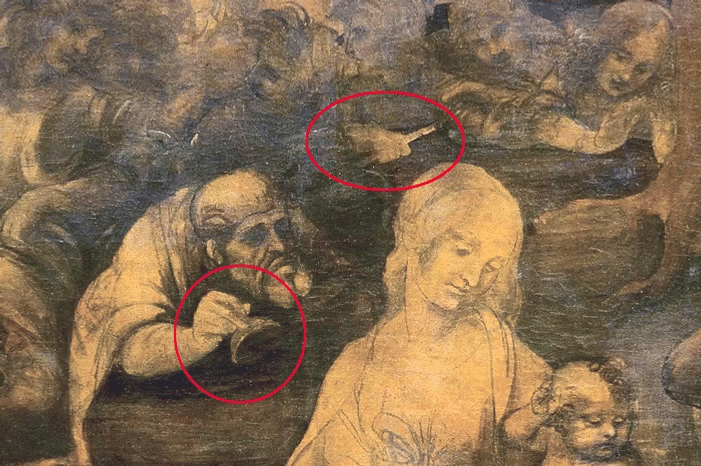
Bell and
blade is the signal to strike |
- Analysis shows the association
between Leonardo’s Magi painting and the version featuring the
Medici family produced by
Botticelli.
-
It appears that Leonardo’s version came first and Botticelli
adapted some of its features in way of a tribute, mirroring
the honor the Magi gave to the Infant King.
- The conspirators
planned to strike when the bell rung at the time of consecration and raising of the Host during Mass.
- And at the same time the congregation closed their eyes and bowed their heads in adoration.
Observe the figure at the Virgin’s right shoulder, leaning forward and ringing a small bell. Another figure to note is the man behind the Virgin. He appears to hold a knife in his right hand. (arnolfinimystery.com)
|

Leo stands |

Botticelli stands |
- Similar to Leonardo, Botticelli placed his own image in the right corner of his painting, looking away from the scene.
DaVinci's - Most historians agree that the standing figure on the extreme right, looking out of the frame, represents Leonardo. The figure standing in the opposite corner, described by historian Joseph Manca as “the unseen scholar” and a philosopher “in the broadest sense” is there to represent Julius Caesar, like his namesake Giuliano de' Medici, assassinated by multiple stab wounds – 23 in total. Nineteen knife wounds were inflicted on Giuliano and a sword also cleaved his head. (arnolfinimystery.com)
|
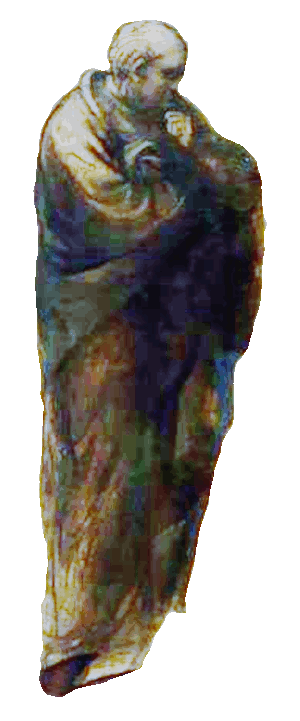
DaVinci Caesar
unseen scholar |

Giuliano stands |
- In the facing corner Giuliano de’ Medici strikes a similar pose to Julius Caesar, his thoughts seemingly elsewhere.
- It is this part of the painting that Botticelli refers to the assassination attempt on the Medici brothers, and also brings to light features which identify with Leonardo.
And Jesus answered and said to them, “Render to Caesar the things that are Caesar's, and to God the things that are God's.” And they marveled at Him. (Mark
12:17)
|
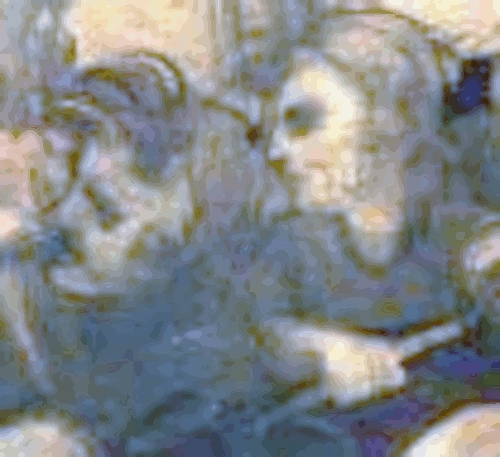
DaVinci's version of the blade
buddies |
-The assassination of Giuliano de’ Medici
is called the Pazzi conspiracy and resulted in the
assassination of Guiliano and the attack on his elder brother Lorenzo at the same time.
- It took place during High Mass in Florence’s Duomo on Sunday, April 26, 1478.
-
Two members of the assassination team assigned to deal with Giuliano had persuaded him to attend the Mass at the Duomo
although he did not want to as he was recovering from an illness.
Francesco de’ Pazzi placed his arms around Giuliano suggesting that the “golden boy”, as he was known, had grown fat during his illness. In reality Francesco de’ Pazzi was checking if Giuliano was wearing armour under his clothes. He wasn’t. (arnolfinimystery.com)
|
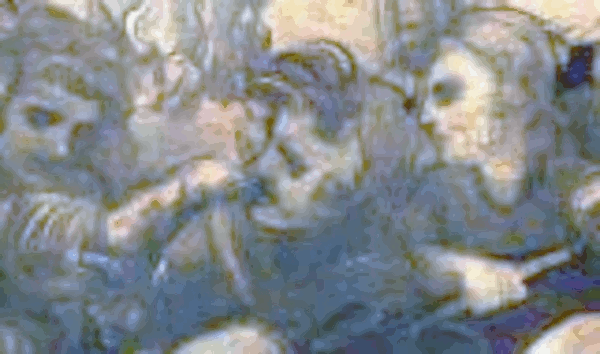
Gun appears to fire |
- One observation, is the Elvis character pointing a gun?
- His buddy is the Marilyn Manson type.
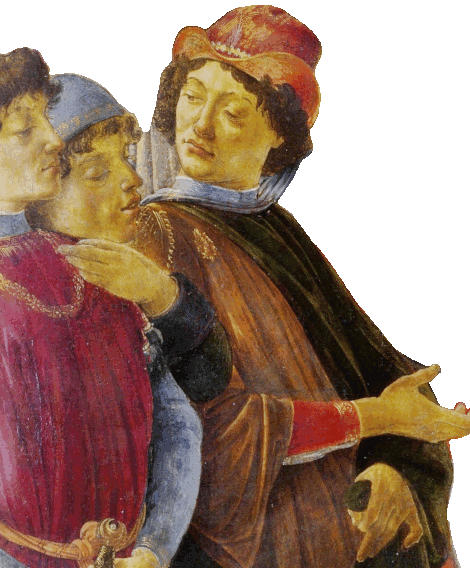
Bernardo Baroncelli grips sword |
- In Botticelli’s painting Giuliano is embraced by his assassin,
Francesco Pazzi, seemingly in an act friendship, but in
reality, an act of betrayal akin to the kiss Judas gave to Jesus.
- Standing next to Francesco is Bernardo Baroncelli, his left hand gripping the concealed hilt of the sword used to cleave Giuliano’s skull.
- The artwork mirrors itself and by him gripping his waist,
this is a sexual signal that references what is going on the
other side of the painting.
His hand is directed towards the two people next in line, the priest Antonio Maffei, and in front of him, Giuliano’s brother Lorenzeo. The figure immediately behind Baroncelli and to the left of Maffei is Stefano Bagnone, the other priest designated to assassinate Lorenzo. As it was, the priests failed in their mission and Baroncelli gave chase to Lorenzo to try and finish him off. (arnolfinimystery.com)
|
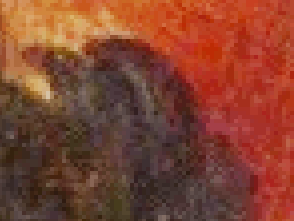
Bird in his hat |
- This figure is also believed to have the face of a young
Leonardo due to characterics representing the Kite in his hat.
- There is also a small feather on the hat band.
- He also
wears a small gold emblem on his shoulder shaped like a leaf
representing his time as an apprentice goldsmith.
- The
golden thread and knot patterns throughout the painting
represent Leonardo's devotion to them.
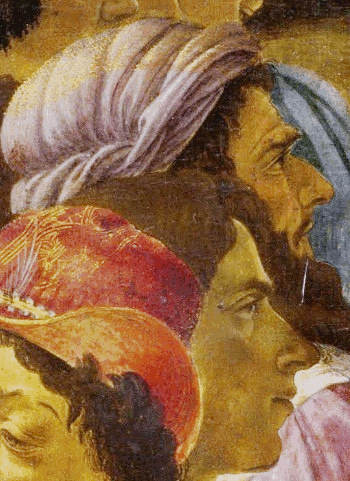
Priest Stefano Bagnone attempted assassin |
- Stefano Bagnone, a priest designated to assassinate
Lorenzo.
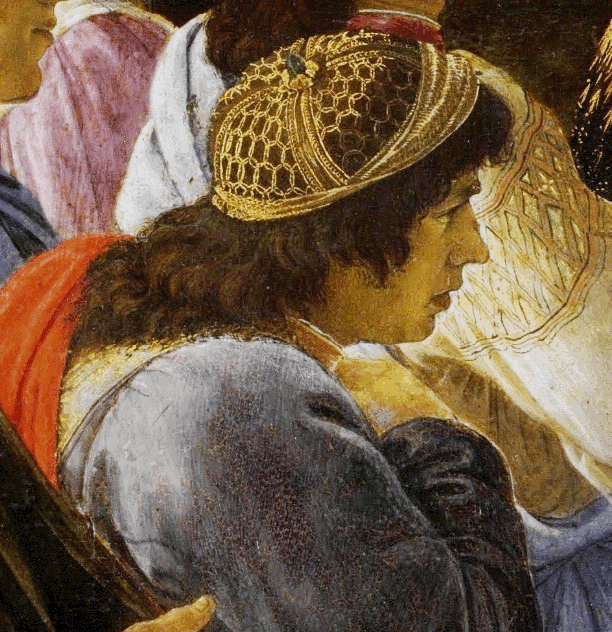
Priest Antonio Maffei attempted assassin |
- A close inspection of Maffei sees his right arm raised and the hand pointing to his neck collar
which is shaped as a blade.
- This signifies his attempt to end Lorenzo’s life with a cut to the throat
and as a result, Maffei had put his own neck at risk.
- The collar now becomes a noose placed around Maffei’s neck.
- Both priests in on the scheme were captured, castrated and then hanged.
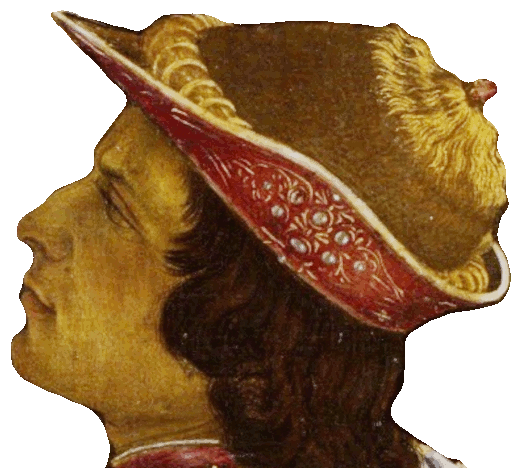
Lorenzo turned |
- Lorenzo had first thwarted Maffei when his attacker had grabbed his shoulder in an attempt to turn him.
- Giuliano was not so lucky and he was stabbed viciously 19
times while his namesake, Caesar had been stabbed 23 times.
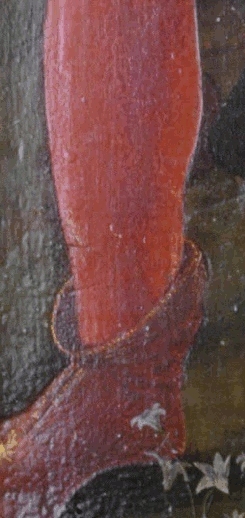
Bloody
hose |
- Francesco’s attack on Giuliano was so violent that he actually stabbed his own leg in the process, which
is symbolized by the red color of his hose.
- Baroncelli
escaped and managed to make his way to Constantinople,
however, he was soon captured by Antonio de Medici, a cousin of Lorenzo, and hanged on December 29, 1479,
19 months after the assassination.

Baroncelli hanging in 1479 by Leonardo |
- Leonardo was present at the time, and made a sketch of
Baroncelli hanging.
- Dressed as a Turk.
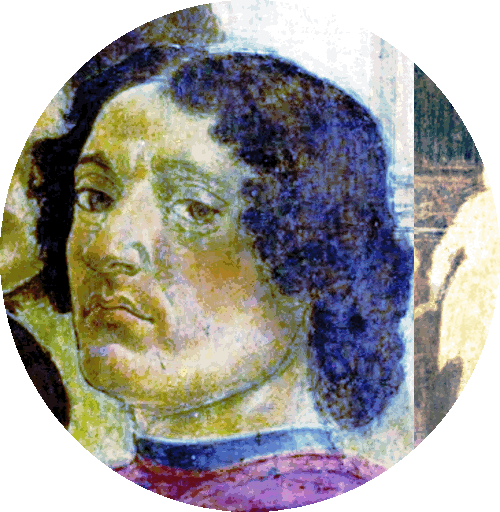
Angelo Poliziano
the poet |
- As Botticelli's Adoration painting has been dated as 1475,
and Giuliano wasn't murdered until 1478, it appears that
Botticelli's date should really be 1480.
- There is other
evidence that the date should be pushed back to 1481 because
of elements from DaVinci that Botticelli incorporated in his
version.
- Scholar and poet Angelo Ambrogini, known by his nickname Poliziano, was standing close to Lorenzo de’ Medici when the attack happened and helped rescue
Lorenzo from his assailants.
- Botticelli also connects the
crime to a participant in the Pazzi consiracy itself, the bishop of Pisa, Francesco Salviati,
who was hung.
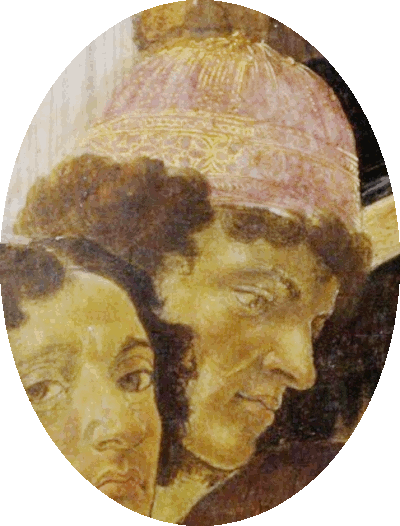
Skull cap of Baroncelli |
- Baroncelli’s hanging head appears behind the head of poet Poliziano
and is shown as a skull (cap) which serves as a reminder that it was
Baroncelli who cleaved the skull of Giuliano with his sword.
- He is also wearing the same colors as Guiliano was wearing
and a vertical line on a column represents the rope he was
hung with..
- Leonardo's hanging man sketch showed the same skull cap.
The reference to the Leonardo sketch implies that Botticelli completed the painting after the date Baronelli was hanged. (arnolfinimystery.com)
|
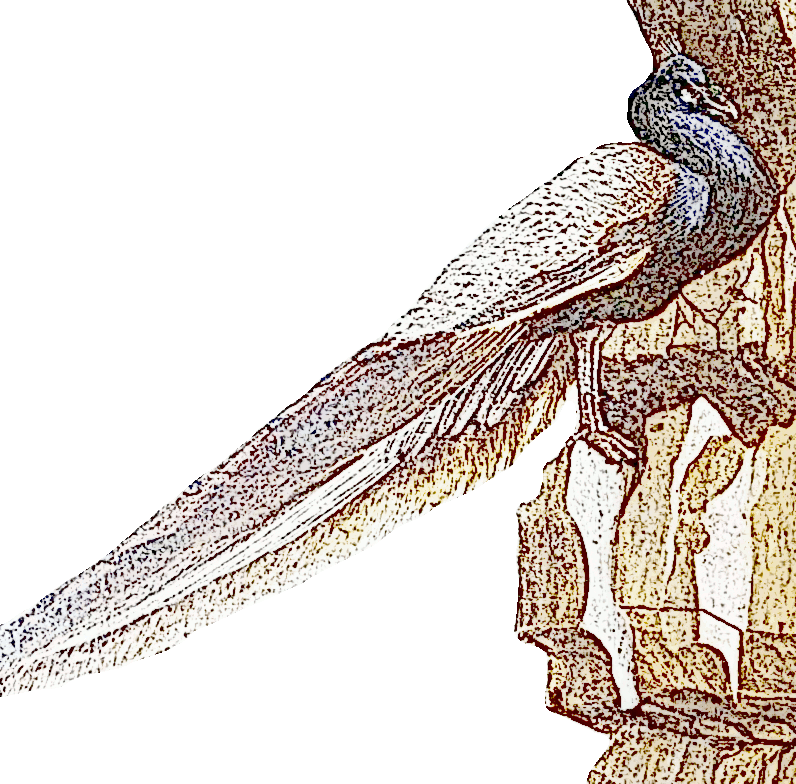
Peacock |
- Botticelli used a lot of humor in this painting and
takes many jabs at Leonardo.
- The peacock we presume is
Leonardo, and the reference to a bird is the Kite that struck
him on his cheek when he was an infant lying in his cradle.
- The shadow of the feathers represents a fork-tail as to
depict a Kite.
Botticelli appears to have referenced the incident in at least two places. It may even be that Botticelli doubted Leonardo’s account and in his irreverent way put it down to fantasy or a dream sequence his contemporary may have experienced at some time. (arnolfinimystery.com)
|
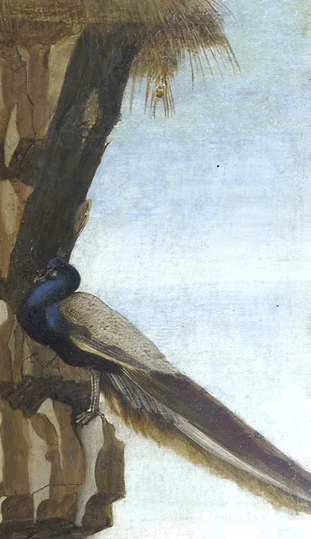
Bird within a bird |
- Also, the shadow on the cliff above the bird depicts a
bird within a bird (l-shape) which may represent the reason
for Leonardo's move to Milan.
- The configuration
also spells 'Leo' since the rock below can be seen as both and
e and o.
The overhang above the peacock is meant to depict the wingspan of another bird, perhaps the kite and the shadow hanging over Leonardo if ever a charge of sodomy was brought against him in the future.. (arnolfinimystery.com)
|
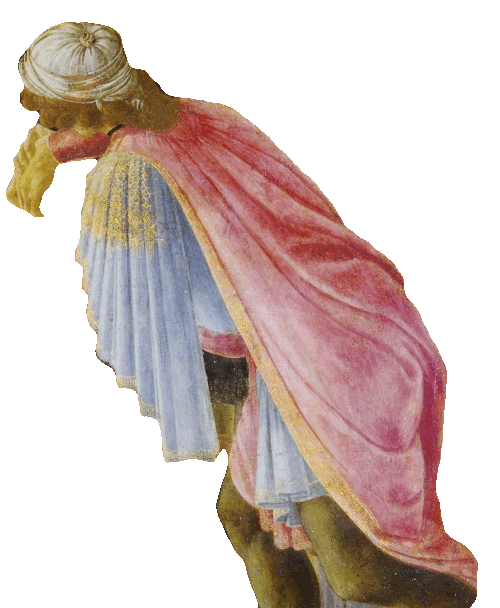
Leonardo with wing |
- Leonardo had a lifelong interest in birds and flight and
Botticelli even showed him as a bird with wings and a cape.
- It also depicts Leonardo's flamboyant style of dress and
notice he is wearing the same colors as Virgin Mary possibly
because he used his face as Jesus in the Last Supper.
Botticelli took the jest a step further, intimating that Leonardo’s weakness, or even strength, could be observed on the underside of his belly, an obvious reference to the sodomy charge against Leonardo and a 15th century slang defintion of ‘kite’ as a person who preys on others. (arnolfinimystery.com)
|
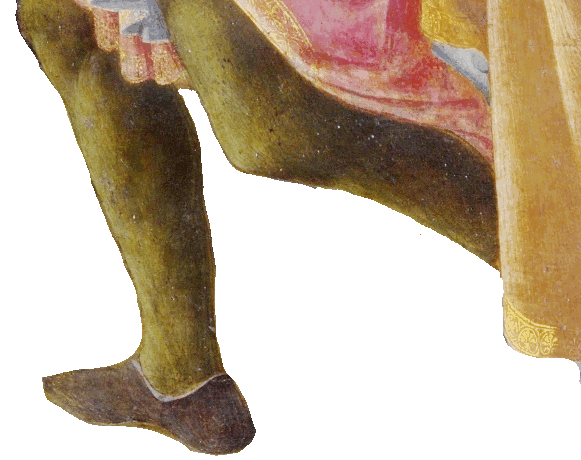
Leonardo missing foot |
- The character of Leonardo also
represents Jacopo Saltarelli, an apprentice goldsmith charged with prostitution and engaging in sodomy with Leonardo and three other men.
- Accusations of this kind were common at the time, often as a way of harming reputations.
- Leo has one foot hidden and that could indicate a life he
was robbed of.
How beautiful are the feet of them who preach the
gospel of peace. (G. F. Handel)
|
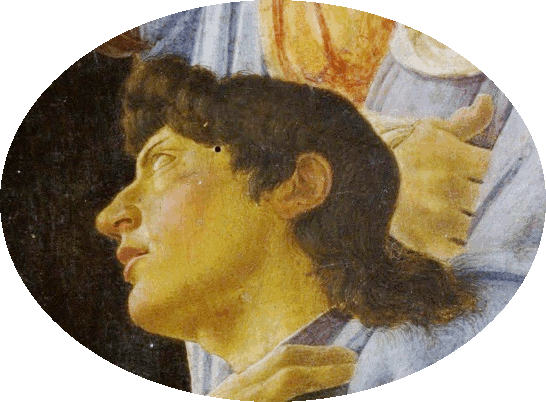
Head wound guy |
- All the figures in the painting play multiple
characters.
- This character plays the wounded Giuliano and
also represents the musician and companion to Leonardo,
Atalante Migliorotti.
- He is placed behind Leonardo and
represents the man pretending to befriend Giuliano de’ Medici before inflicting 19 wounds on his body.
- If the portrait depicts Leonardo in distress, then perhaps it was Giuliano who gave his support when he was anonymously acused with four other men of sodomy
and two months the charges were dropped.
Whereas Leonardo dissected human corpses, animals and birds in his quest for knowledge, Botticelli dissected reputations with his cutting remarks and piercing parodies for comic effect, even to the extent of self-parody. (arnolfinimystery.com)
|

Flemish artist |
- Flemish artist Hugo van der Goes in the role of Balthazar, said to be a Babylonian scholar, in the secondary line of Magi.
- Most of the men
standing next to Hugo represent the main artists involved in the Sistine Chapel project.
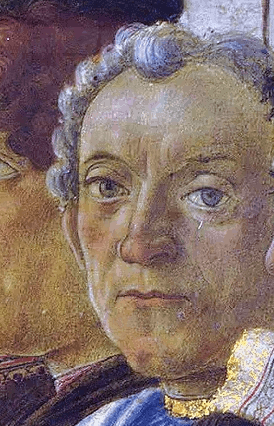
Art patron Gaspare |
- Gaspare di Zanobi del Lama, presumed to have
commissioned the painting which made him important to the art
community.
- Other scholars believe this to
be Andrea del Verrocchio who was DaVinci's mentor and it does
resemble a self-portrait about 1470.
- Verrocchio’s workshop trained many artists and skilled craftsmen and was possibly a liaison link between the artists commissioned by Pope Sixtus IV
for the Sistine Chapel project.
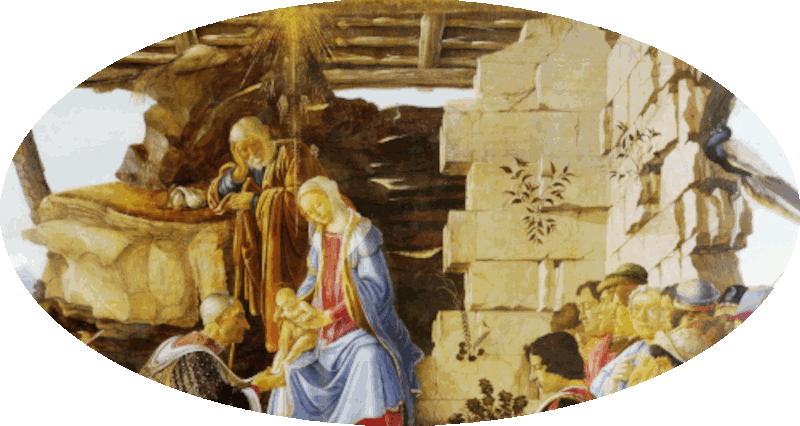
Sphinx stones |
- The right side of the stone wall represents the sejant erect heraldic lion
which is the symbol of Florence known as the Marzocco.
-
It is placed alongside the infant Jesus and symbolizes the sacrificial Lamb of God, it becomes the Lion and Lamb peace symbol.
- Sculpted from the rock shelf which Joseph is leaning on is a head representing Leonardo
DaVinci.
- When this is merged with the lion feature it produces a sphinx-like form of half-man and half-lion.
- It wasn’t the first time Botticelli had portrayed Leonardo as the Sphinx.
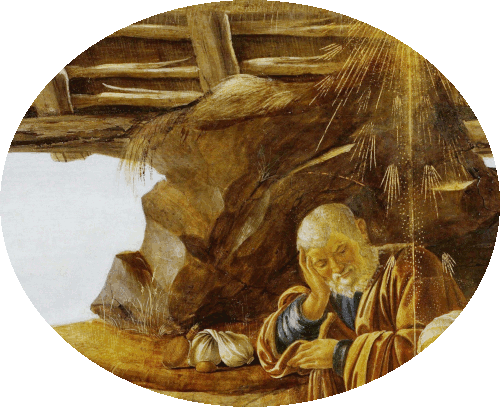
Lion of Babylon |
- Botticelli was mocking Leonardo's notebooks about his
trips to Egypt and many historians feel it was all a
fantasy.
- The dark rock over Joseph also represents a
bull and Leonardo's letter to the Sultan of Babylon in Cairo and his
time in Armenia and the Taurus Mountains.
- This also may
refer to the Babylon Captivity as a symbol of oppression and
Leonardo pinned underneath was oppressed by the Florentine
authorities who were more than likely pressing false charges
against him.
- Which was the reason he left for a new
beginning in Milan.

Spirit
of Thutmose IV |
-
Two tree trunks supporting the roof of the building show the Roman numeral IV
(4) and connect to the pharaoh Thutmose IV who
restored the Great Sphinx of Egypt.
- The Sphinx is
holding the Dream Stele in his paws and this was to
legitimize his rule because many believe he was a ruthless
usurper and seized the thrown from his older brothers.
- It also symbolizes Pope Sixtus IV.
- The Sistine Chapel project was seen as signifying unity
between Pope Sixtus IV and the Medici family and was a
symbolic sign of reconciliation and peace between two
powerful world forces, once again.
The Pope’s family name of Della Rovere means “of
the oaks” or “the place of the oaks”. So here we see
Botticelli expressing the Pope’s desire to take
control of the Florentine Republic of which Lorenzo
de’ Medici was the de facto ruler. (arnolfinimystery.com)
|
|
|

